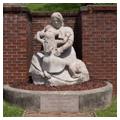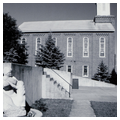You are here
International Mother's Day Shrine (Andrews Methodist Church)
Grafton's claim to fame is this brick church just northwest of the B&O complex. Built as the First Methodist Church and later named Andrews Methodist Church, it is now known as the Mother's Day Shrine. On Sunday, May 10, 1908, Anna Jarvis (see also TA7) supplied 500 white carnations that were distributed at the morning service to worshipers to wear in honor of their mothers. Jarvis, who had grown up in the church, was then living in Philadelphia, and a similar service held the same afternoon at the Wanamaker department store drew an audience of several thousand. In 1914 President Wilson signed a resolution designating the second Sunday in May as the nation's official Mother's Day. Because the church was the site of the nation's first Mother's Day service, the Secretary of the Interior declared it a National Historic Landmark in 1992.
The building is a late and subdued example of Rundbogenstil, the German version of Romanesque Revival. As the name of the style suggests, openings are typically round-arched. Plain brick pilasters separate the bays, and a corbeled brick cornice terminates the walls. The tower projects slightly from the gabled facade and supports an octagonal wooden belfry, once crowned by a more imposing steeple than the ineffectual pinnacle that now tops it.
Organ pipes, framed in a recessed opening supported by clustered colonnettes, form the focal point above and behind the central pulpit in the second-floor auditorium. To each side and along side walls between art glass windows, large paintings of Biblical scenes, installed c. 1910, provide an almost Roman Catholic ambience. The flat ceiling is made of decorative pressed tin.
In 1957 the congregation merged with another Methodist congregation and subsequently moved to a new building, leaving this church to serve as a Mother's Day shrine. A small greensward west of the church is part of an urban renewal project designed both to clean up downtown and to promote the Mother's Day theme. A statue titled Mother with Children (1982, William Douglas Hopen) is the centerpiece.
Writing Credits
If SAH Archipedia has been useful to you, please consider supporting it.
SAH Archipedia tells the story of the United States through its buildings, landscapes, and cities. This freely available resource empowers the public with authoritative knowledge that deepens their understanding and appreciation of the built environment. But the Society of Architectural Historians, which created SAH Archipedia with University of Virginia Press, needs your support to maintain the high-caliber research, writing, photography, cartography, editing, design, and programming that make SAH Archipedia a trusted online resource available to all who value the history of place, heritage tourism, and learning.

















